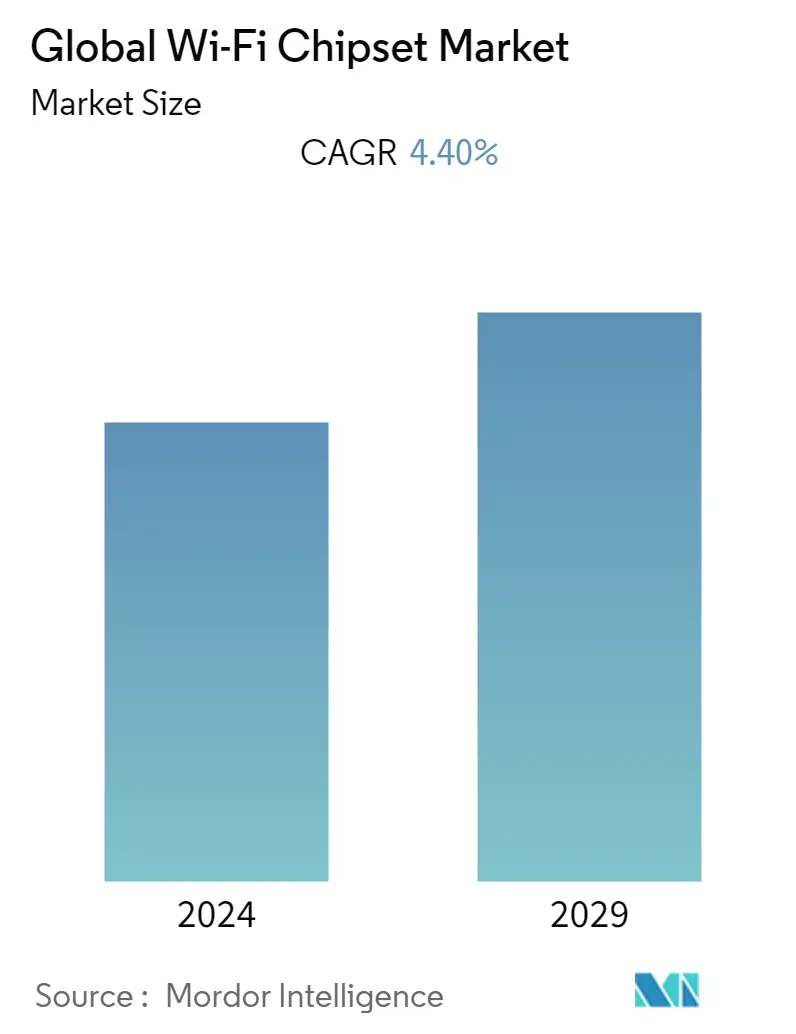Market Size of Global Wi-Fi Chipset Industry

| Study Period | 2019 - 2029 |
| Base Year For Estimation | 2023 |
| CAGR | 4.40 % |
| Fastest Growing Market | Asia-Pacific |
| Largest Market | North America |
| Market Concentration | Medium |
Major Players
*Disclaimer: Major Players sorted in no particular order |
Need a report that reflects how COVID-19 has impacted this market and its growth?
Wi-Fi Chipset Market Analysis
The Global Wi-Fi Chipset Market is expected to grow at a CAGR of 4.4% during the forecasted period of 2022 to 2027. Due to the growing popularity of smartphones worldwide, Wi-Fi technology has increased usage. Furthermore, governments worldwide are building smart cities with public Wi-Fi networks to help service industries, such as education and healthcare. These factors increase Wi-Fi usage in homes, offices, and public spaces, increasing Wi-Fi chipset sales. Customers prefer Voice-Over Mobile Broadband (VOMBB) over traditional telecom carriers because of its great audio quality, lower cost, and ability to save power, fueling demand for Wi-Fi services worldwide.
- According to the Organisation for Economic Co-operation and Development survey, By 2025, the number of households having a computer is expected to increase to 1,262.47 million. Homes with at least one computer are referred to as computer households. Such a huge increase in computer adoption will create aopportunity for the market players to expand their Wi-Fi chipset product portfolio, expand their presence in different regions, and increase their market share.
- Consumers focus on the value of information as the number of connected devices grows exponentially. Many people have multiple sources of information and are increasingly reliant on mobile devices and the Internet. Through Facebook pages, e-mails, and location-based marketing, retailers see the benefit of supporting customers in gathering information and building customer relationship management systems. Furthermore, merchants are increasingly using in-store Wi-Fi to engage with customers and enable them to make purchasing decisions. Consumers shopping habits have shifted as a result of mobile devices. Mobile users read options and reviews, check a retailer's product availability, access interactive store maps, view discounts and loyalty offers, and make online purchases using mobile devices.
- According to a report from Snapchat, by 2025, around 75% of the global population and almost all smartphone users will be frequent AR technology users, out of which more than 1.5 billion are anticipated to be millennials. According to GSMA's Mobile Economy China 2021, China will be adding around 340 million smartphone connections by 2025, with adoption rising to 9 in 10 connections with 1.5 billion in Mainland China, 12.3 million in Hong Kong, 1.9 million in Macao, and 25.7 million in Taiwan.
- The increasing activities of cyber criminals successfully penetrating and moving laterally within the security perimeter are expected to increase privacy concerns. Organizations relying solely on on-premises firewalls and VPNs lack the visibility solution integration and agility to deliver timely end-to-end security coverage. As evidence, large-scale, multi-vector mega attacks are growing, wreaking havoc on organizations and individuals worldwide.
- However, according to the Semiconductor Industry Association, after Q1 of 2020, the semiconductor industry started the recovery in line with the global demand for electronics such as laptops and desktops for the growing trend of Work from Home. Despite logistical challenges related to the coronavirus, semiconductor facilities in Asia-Pacific usually function with high-capacity rates. Moreover, most semiconductor operations in various countries, such as South Korea, continued uninterrupted, and chip exports grew by 9.4% in February 2020.
